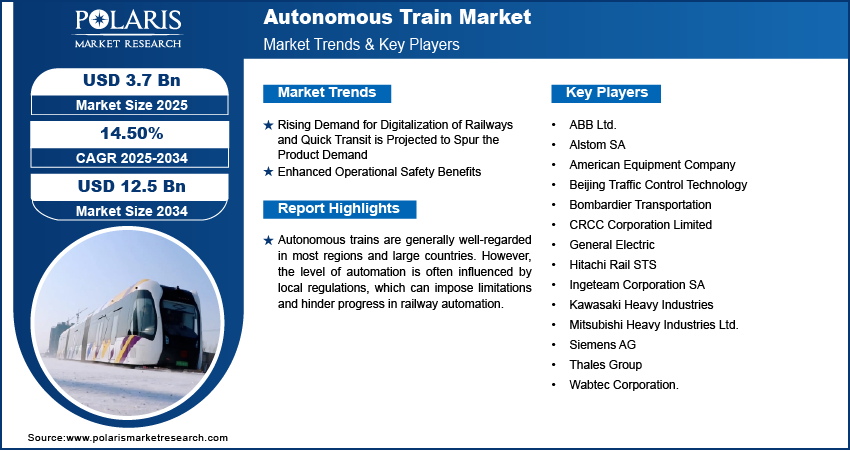Autonomous Train Market anticipated to reach USD 12.5 billion by 2034, advancing at a CAGR of 14.50%

The global Autonomous Train Market was valued at USD 3.2 billion in 2024 and is anticipated to grow at a CAGR of 14.50% from 2025 to 2034. Technological innovations in autonomous navigation and safety monitoring are revolutionizing the global rail transport infrastructure.
Market Trends & Insights
- Integration of AI and IoT: Autonomous trains are increasingly equipped with AI-powered analytics and IoT sensors for real-time data processing, predictive maintenance, and improved operational efficiency.
- Driverless Metro Systems: Urban areas are expanding fully automated metro networks to meet growing commuter demand while minimizing human error and operational costs.
- High-Speed Autonomous Rail: Several countries are exploring autonomous solutions for high-speed rail corridors, targeting reduced travel time and enhanced safety.
- Digital Twin and Simulation: Virtual modeling and simulation tools are being adopted to test and optimize autonomous train systems before physical deployment.
- Sustainability Goals: Automation helps in optimizing energy consumption and reducing emissions, aligning with global environmental objectives and climate commitments.
Market Size & Forecast
Market size value in 2025 USD – 3.7 billion
Revenue forecast in 2034 USD – 12.5 billion
CAGR – 14.50% from 2025 – 2034
Request for Free Sample:
https://www.polarismarketresearch.com/industry-analysis/autonomous-train-market/request-for-sample
Market Overview
The global autonomous train market is undergoing transformative growth, driven by the demand for safe, efficient, and cost-effective rail transport systems. Autonomous trains use advanced technologies such as artificial intelligence (AI), automatic train operation (ATO), communication-based train control (CBTC), and real-time monitoring systems to operate with minimal or no human intervention. These trains are increasingly being deployed in urban transit systems, high-speed rail networks, and mining operations to enhance punctuality, safety, and energy efficiency. As smart mobility becomes a core component of sustainable urban planning, autonomous train systems are gaining momentum across developed and emerging economies.
Market Growth Drivers
· Urban Population Growth: Increasing urbanization is driving the need for efficient, high-capacity rail transit systems, encouraging autonomous rail deployments.
· Improved Safety and Efficiency: Automation reduces the likelihood of accidents caused by human error and ensures consistent performance with minimal delays.
· Government Investments in Smart Mobility: Public infrastructure programs worldwide are supporting smart transportation initiatives, including autonomous rail systems.
· Cost Optimization: Autonomous trains help reduce long-term operational costs by minimizing labor dependency and enhancing asset utilization.
· Technological Advancements: Progress in AI, 5G communication, LiDAR, and machine vision technologies is enabling safer and more reliable autonomous train operations.
Market Challenges
- High Infrastructure Costs: Upgrading existing rail networks to support autonomous train market operation involves significant capital investment in signaling, control, and communication systems.
- Cybersecurity Concerns: As trains become more connected, they are vulnerable to cyberattacks, requiring robust security frameworks.
- Regulatory and Standardization Issues: The absence of globally harmonized safety standards and regulations for autonomous train operations can hinder cross-border deployments.
- Technical Complexity: Developing and integrating autonomous technologies into legacy systems requires advanced technical expertise and system compatibility.
- Public Acceptance and Safety Perception: Concerns over passenger safety in fully driverless systems may slow down adoption, especially in conventional rail segments.






